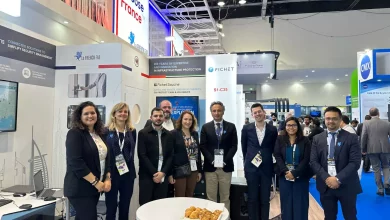Achieving Sustainability Goals in the Era of AI
في يوم 19 سبتمبر، 2024 | بتوقيت 7:32 م

كتبت: Nagwa Taha
Technologies.Have you ever wondered if artificial intelligence (AI) can help us build a more sustainable and equitable future?
Today, as AI seamlessly integrates into our daily lives, its adoption and impact are no longer a question of ‘if’ but ’when’ and – most importantly – ’how’. According to a Dell Technologies study, 76% of IT leaders believe that generative AI (GenAI) will be significant or transformative for their organizations. Meanwhile, McKinsey estimates that work automation using GenAI and other technologies will boost productivity by 60-70%.
Of course, implementing AI is not as simple as flicking a switch. One of the major challenges is the energy intensity of the technology. According to a Gartner® report1, increasing adoption of GenAI will lead to dramatic increases in energy use, with annual ICT electricity increases of 25% or more. These increased emissions and water consumption could result in vendors failing to meet environmental performance targets established in application selection processes. As AI starts delivering on its enormous potential to increase productivity and power more efficient processes, forward-thinking businesses are faced with the challenge of adopting energy-intensive AI capabilities without compromising vital sustainability and energy efficiency objectives – all while maintaining data sovereignty and ensuring optimal return on investment.
Let’s explore how businesses can adopt and integrate AI as part of an enterprise-wide transformation that’s focused on driving sustainability and energy efficiency priorities forward.
1. Accelerating efficiencies in the data center
Adopting energy-efficient infrastructure is a powerful way to advance sustainability in an organization’s data center. AI can support this by driving efficiencies while enhancing the company’s ability to monitor and control its carbon footprint. Net zero targets have come thick and fast in recent years. The European Union aims to cut green-house gas emissions (GHG) by 55% by 2030 compared to 1990, and the ‘European Green Deal’ has mandated climate neutrality in the EU by 2050. With these ambitions, new corporate sustainability reporting standards have begun to come into force. More and more organizations operating in Europe are obliged to report on their ESG efforts, and these new standards may come to have significant global influence as well.
Energy-efficient technology has also evolved significantly over the years, rendering old hardware a burden. What took six servers in 2013 takes just one today. Meanwhile, innovative software and remote management solutions can provide an overview of the organization’s energy usage and environmental impact.
By carefully designing their IT environment in line with their priorities, businesses can find a balance between reducing their physical footprint, increasing efficiency and equipping themselves with the capacity they need to grow. However, as companies approach IT transformation, what they do with their data will have implications for future growth. 37% of respondents to the 2023 Dell GenAI Pulse Survey indicated that their data and intellectual property are too valuable to be placed in a GenAI tool to which a third party might have access. By bringing AI to your data, you can maintain data sovereignty while embracing the benefits of GenAI.
2. The as a Service (aaS) model enables AI transformation while advancing sustainability
Demand is growing for flexible consumption models, and the greater agility they offer is well-suited to optimization for deploying AI workloads. As per a Forrester study, 88% of businesses anticipate sustainability benefits from adopting an aaS model and 65% expect savings of more than 10% by doing so. An aaS model can ensure that companies continue to operate with the latest hardware that boasts the best energy efficiency and is produced to the highest sustainability standards. By opting for an aaS model, businesses can cut costs and reduce waste while gaining more control over their applications and data, thereby allowing them to modernize their IT environment and scale with AI where necessary.
3. Adopt AI without compromising energy efficiency to drive the future of work
Modern devices are increasingly being designed, manufactured and shipped with sustainability in mind, in addition to having intelligent AI-enabled features that keep users productive. For example, Dell Optimizer learns and responds to how users work, adjusting performance to meet peak worktimes and extending battery life through intelligent power-saving features. Applying energy settings appropriate to performance requirements, powering down at the end of the day and using rechargeable and USB-powered peripherals can help advance energy efficiency. In addition, businesses can take advantage of regular refresh cycles to ensure that they operate with the latest energy-efficiency technology, reducing upfront costs and Total Cost of Use (TCU) while driving operational benefits and supporting sustainability objectives.
Leveraging AI to chart a roadmap to sustainability
Adopting energy-efficient infrastructure is a powerful way to advance sustainability and is already bringing about a radical shift in how businesses approach innovation and growth. However, adopting AI is a matter for the entire organization, so to make the most of these opportunities, businesses must adopt a holistic approach, bringing leaders from across the organization together to collaborate and integrate AI-led strategies into every facet of their operations. The era of AI has begun, and there has never been a better time to advance multi-faceted energy-efficient and sustainable priorities.
###
1Gartner, “Predicts 2024: Sustainability Reshapes IT Sourcing and Procurement,” Stephen White, James Smith, Hannah Decker, DD Mishra, Rob Schafer, November 23, 2023 (GARTNER is a registered trademark and service mark of Gartner, Inc. and/or its affiliates in the U.S. and internationally and is used herein with permission. All rights reserved.)













